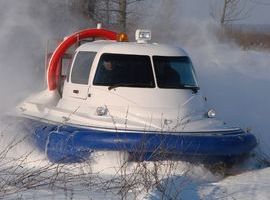Care after the air-cushion craft
Before using any cleanser or any new way of repair, try them on an inobservable part of the hull in order to make sure the result will be positive.
Cleaning inside the hull
The interior of the cabin is cleaned from mud, sand and oil spots with the help of soft brushes, fabric and special cleansers.
NB! Do not use flammable solvent (e.g. kerosene) for cleaning the interior of the cabin.
Fiberglass and gelcoat
The hull is fiberglass. The surface is covered with gelcoat containing pigment which gives a bright permanent colouring to the ship. The gelcoat is resistant to scratches and mechanical damages, too.
Care after the gelcoat
When home detergents are used, check if they contain aqua ammonia or chloride. Aqua ammonia and abrasive cleansers give black discoloration and decolorize the gelcoat and are not recommended to be often used. The gelcoat should be regularly cleaned with soft home detergents solutions. To keep the glance of the gelcoat, polish it regularly with special wax for fiberglass surfaces which fills in micropores in the gelcoat. Besides, wax contains chemical substances protecting the fiberglass surface from damage of ultraviolet rays which result in black discoloration and deterioration of the gelcoat.
NB! Do not polish the fiberglass where people move around. Both the dry, polished and wet (not wiped with dry fabric) gelcoat is extremely slippery and can serve as a reason for falls and injuries.
Small spots:
- remove with soft fabric and a home detergent. Wash down with water afterwards.
- If the spot is deep down in the gelcoat, use a special cleanser for fiberglass only.
Small scratches:
- small scratches are removed with the help of automobile wax. With its help you can either remove them completely or make them less visible.
- Put a little wax on soft, slightly wet fabric
- polish the gelcoat surface with wax by taking roundabout motions
NB! Use wax in accordance with the manufacturer's manual.
Breakaway and damage
If the gelcoat is damaged in service, order a repair unit for the gelcoat of a suitble color from your dealer. Point out the model, colour and year of the craft so that the colour could match.
NB! When using the repair unit, the temperature outside must be higher than 18°C.
- Make the damaged spot free from mud, wax, oil and make it dry.
- Polish the break with sand paper #50 or use a fine grinder. Make it round
and make sharp angles flat. Open the breakaway.
NB! If the damaged spot is big, the grinding machine can be used. - Use spirit or acetone on the reverse side.
NB! Acetone is a toxic liquid. Use it in a well air-conditioned room. Never have fabrics soaked with acetone or another solvent on board the ship to prevent fire. - Put one teaspoonful of gelcoat on a part of laminated wood or cardboard.
- Add 2-3 hardener drops. Stir the hardener within 15-20 sec.
- Put gelcoat on the damaged place so that its surface could be higher than the main surface of the fiberglass.
- Cover it with wax paper or clean polyethylene foil and make it flat.
- Let it hardened to its full. It usually takes 1-2 hours.
- Put down the paper or foil. Polish the surface with sand paper #600 in a dry or wet way.
- Polish the damage with a special polishing solution. Put and rub the wax. Try not to polish long on one and the same place when you resort to a polishing machine with an electric drive – you can burn the surface.
NB!
Hull material is fiberglass – of light type having decorative coating. So crocodiling is possible on the surface of decorative coating; this is not bad quality. This defect is not significant because the main fiberglass construction is not damaged.



